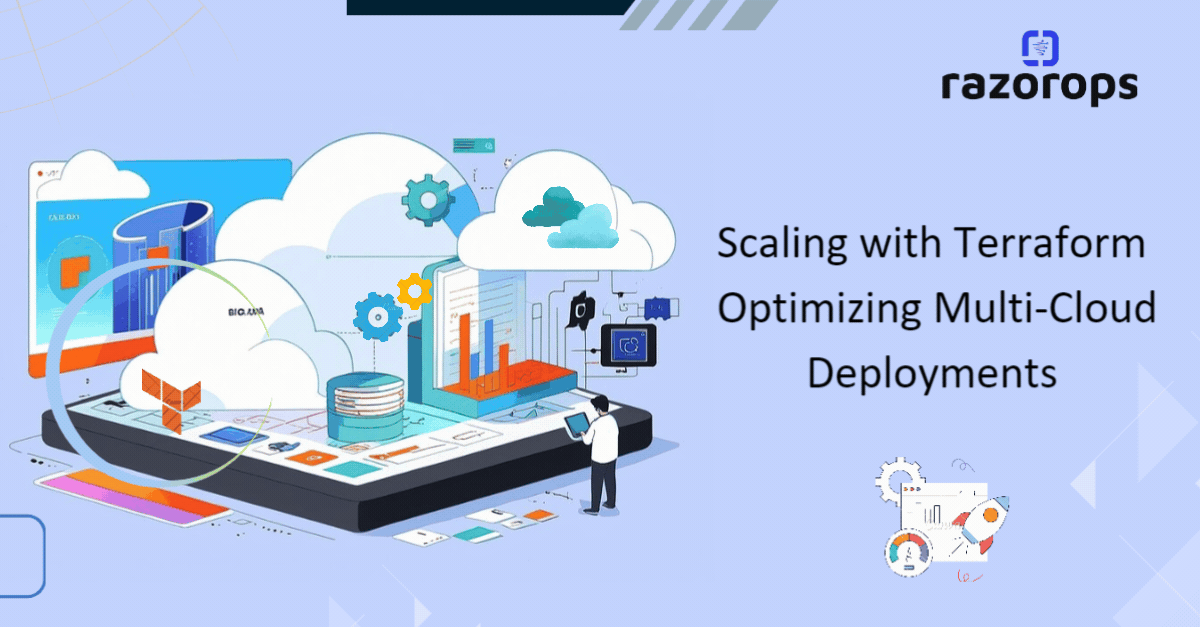
Scaling with Terraform Optimizing Multi-Cloud Deployments
As businesses evolve, their infrastructure needs become increasingly complex, often spanning multiple cloud environments. With the growing trend towards multi-cloud strategies, ensuring seamless deployment, management, and scaling across these environments becomes essential. This is where Terraform shines as a powerful Infrastructure as Code (IaC) tool, offering unmatched flexibility for managing infrastructure in a multi-cloud world.
Why Multi-Cloud?
Adopting a multi-cloud strategy allows businesses to leverage the best features of various cloud providers, avoid vendor lock-in, and enhance redundancy. However, managing multiple clouds can introduce complexities—differing interfaces, APIs, and tooling requirements. Terraform’s cloud-agnostic nature eliminates these challenges by providing a unified interface to manage your entire infrastructure across multiple clouds.
Benefits of Terraform in Multi-Cloud Environments
1. Cloud-Agnostic Flexibility
Terraform’s provider model allows for seamless management across AWS, Azure, GCP, and other cloud platforms. With a single set of configuration files, you can deploy resources across any cloud provider.
2. Infrastructure Consistency
Managing infrastructure across multiple clouds can lead to inconsistency and drift. Terraform ensures that your infrastructure code is consistent across all environments, regardless of the cloud platform used.
3. Scalability
As your infrastructure grows, scaling across multiple clouds becomes critical. Terraform’s modular approach and reusable code structures enable you to easily scale infrastructure while maintaining control.
4. Automation
Automation is key when managing multi-cloud deployments at scale. Terraform’s declarative syntax allows you to automate the provisioning, updating, and scaling of resources, removing the manual complexity of managing each cloud provider individually.
Best Practices for Optimising Multi-Cloud Deployments with Terraform
1. Leverage Terraform Modules
Using modules enables you to abstract and reuse infrastructure components across multiple cloud environments. By defining a module once, you can apply it across AWS, Azure, and GCP, ensuring consistency while reducing code duplication.
2. Manage State Effectively
Terraform tracks your infrastructure’s current state via state files, which can become cumbersome in multi-cloud environments. Use a remote backend such as Terraform Cloud or Amazon S3 with DynamoDB to ensure that state is securely stored, shared across teams, and supports lock management for concurrent updates.
3. Adopt Infrastructure Testing
Testing your infrastructure before deploying it is critical, especially in a multi-cloud scenario. Tools like Terratest can help you write automated tests for your infrastructure code, ensuring that your Terraform configurations work as expected across all clouds.
4. Implement Role-Based Access Control (RBAC)
Multi-cloud deployments require careful access control management to avoid security risks. Use Terraform to automate the creation of access policies, ensuring that only authorized teams can deploy or modify resources in specific cloud environments.
5. Monitor and Optimise Costs
With multi-cloud deployments, cost management becomes a concern. Use Terraform to integrate with cloud-native cost management tools like AWS Cost Explorer, Azure Cost Management, or GCP Billing, allowing you to track, optimise, and automate budget control across environments.
6. Utilise Continuous Integration/Continuous Deployment (CI/CD) Pipelines
Automate your Terraform workflows with CI/CD pipelines, ensuring that infrastructure changes are tested and deployed automatically. Tools like Jenkins, GitLab CI, and GitHub Actions can be integrated with Terraform to manage infrastructure lifecycle changes across multiple clouds.
Scaling Strategies with Terraform
Horizontal Scaling
Terraform can easily scale your infrastructure horizontally by adding more instances or services. With cloud providers offering managed services like auto-scaling groups in AWS or virtual machine scale sets in Azure, Terraform can dynamically increase capacity based on your needs.
Vertical Scaling
Terraform supports vertical scaling by modifying resource configurations, such as increasing instance sizes or memory allocations. You can manage scaling policies across different cloud platforms using a unified Terraform configuration.
Hybrid Scaling
In a multi-cloud scenario, you may want to balance workloads across clouds for performance, redundancy, or cost reasons. Terraform can help orchestrate hybrid scaling solutions, leveraging the best features of each cloud provider to optimise your deployments.
Conclusion
Optimising multi-cloud deployments can be challenging, but Terraform makes it possible to manage complex, scalable infrastructures with ease. Its cloud-agnostic design, robust automation capabilities, and modular infrastructure management enable organisations to fully harness the benefits of multi-cloud strategies. By following best practices and scaling strategies, you can ensure your multi-cloud deployments are secure, cost-effective, and highly scalable.
Start scaling smarter with Terraform and unlock the potential of your multi-cloud infrastructure!
Tutorials & Guides
Top Reading Recommendations
Upcoming Events
Cloud Native Coimbatore - Sep 2024 Meetup
Sep 21, 9 :30 AM - 12:30 PM (PST)
Sep 21, 10:00 AM – 4:00 PM (PST)
Workshop #1 practico Contenedores
Sep 22, 12:30 AM – 03:30 AM (PST)
DevOps Jobs
Google - Check out all the jobs here
Accenture - Check out all the jobs here
Infosys - Check out all the jobs here
Microsoft - Check out all the jobs here
P.S. We publish this newsletter every week, so be sure to subscribe and share it with your friends! We hope you found this edition informative and valuable. Don’t forget to follow the Razorops, Inc. to stay updated on the latest trends in DevOps and CI/CD.
Ready to elevate your DevOps journey? Sign up for RazorOps today and experience the power of automation, efficiency, and innovation firsthand. Your team and projects deserve the best start your FREE trial now!





